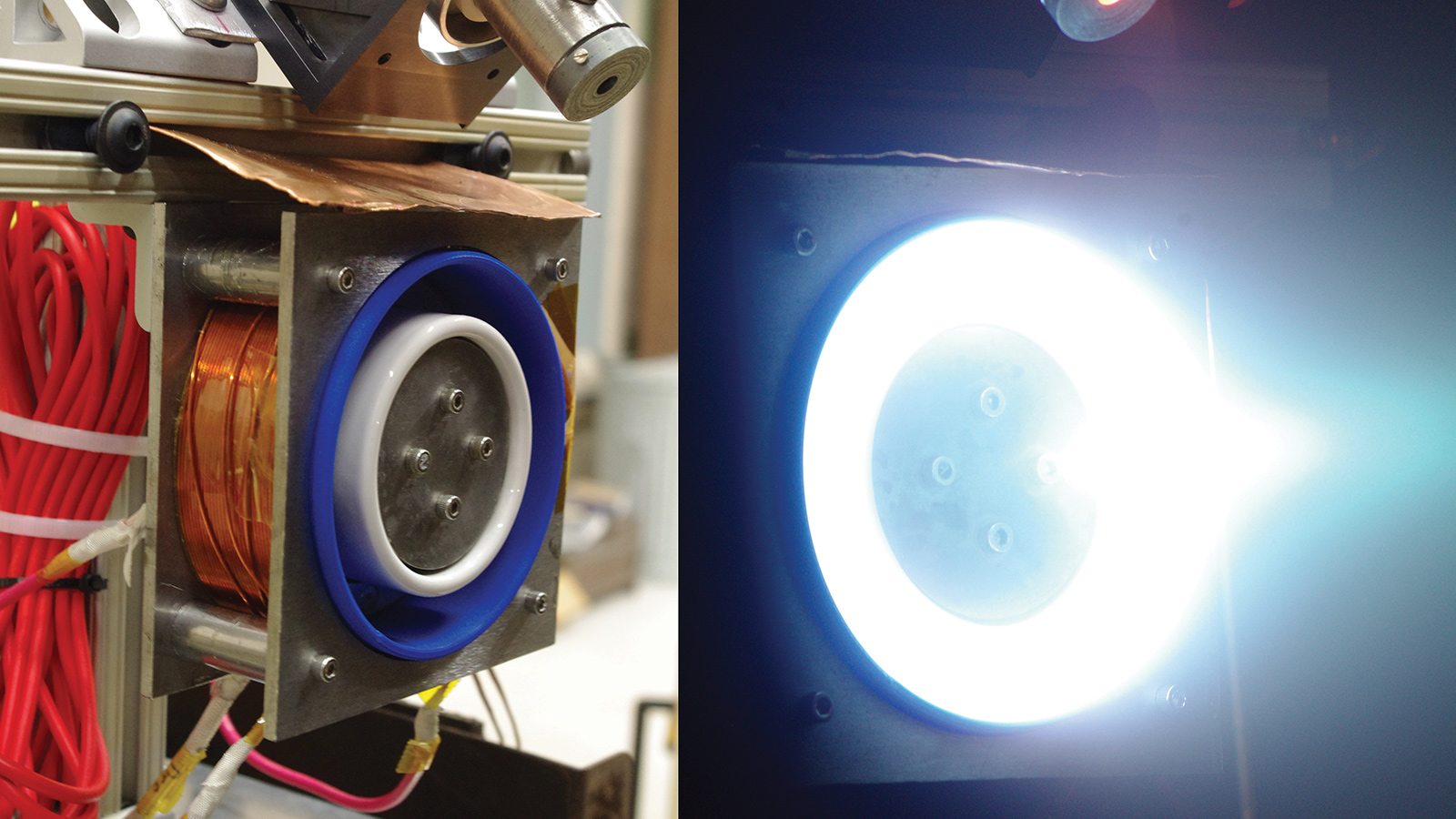Stay Up to Date
Submit your email address to receive the latest industry and Aerospace America news.
The Electric Propulsion Technical Committee works to advance research, development and application of electric propulsion for satellites and spacecraft.
Many significant achievements in electric propulsion occurred this year, including the development and testing of new thrusters as well as the use of electric propulsion in space missions.
The University of Alabama in Huntsville this year developed and tested a miniature Hall effect thruster with an additively manufactured body, propellant distributor and discharge channel at NASA’s Glenn Research Center in Ohio and demonstrated the same performance as conventional miniature Hall effect thrusters but at lower cost and fabrication time.
California-based Phase Four tested radio frequency thrusters for a cubesat and a small satellite in April and May. These thrusters are electrodeless and thus can be mass produced cost-effectively.
Rafael of Israel’s heaterless hollow cathode finished a 5,000-hour endurance test in May. The low-current cathode generated discharge current of 0.8 amperes at mass flow rate of 2.5 standard cubic centimeters per minute and functioned without errors.
NASA used data from low-power tests done in September 2017 of the SSL-made SPT-140 Hall effect thruster to update thruster modeling and trajectory computations and to select thruster operating conditions. The thruster will be used in the Psyche mission, which will explore the metal asteroid thought to be the core of an early-forming protoplanet destroyed by collisions. Psyche will be the first mission to operate Hall thrusters beyond cislunar space.
NASA released a broad agency announcement in September for the power and propulsion element, or PPE, of the Lunar Orbital Platform-Gateway. One solar-powered electric propulsion technology that may be leveraged on PPE is the Advanced Electric Propulsion System, a 14-kilowatt Hall thruster. NASA completed environmental testing in June and completed a 4,000-hour wear test in August of the 12.5-kW Hall
Effect Rocket with Magnetic Shielding thrusters to inform the Advanced Electric Propulsion System thruster design.
One portion of NASA’s Next Space Technologies for Exploration Partnerhips, or NextSTEP, program is high-power electric propulsion. The program requires ground test operation at 100 kW for 100 continuous hours. To prepare for this, Ad Astra Rocket Co. developed key components of its VASIMIR VX-200SS, which accumulated 100 hours in a series of tests concluding in December 2017. Aerojet Rocketdyne’s entry in NextSTEP is the X3 Nested Hall Thruster, which had a test scheduled for November.
After the demonstration in 2017 of Busek of Massachusetts’ Colloid Micronewton Thrusters, NASA’s Jet Propulsion Laboratory and Busek this year continued technology development through the U.S. LISA project. A long-duration test of Busek’s BHT-600 thruster began in June using xenon, and alternate propellants including iodine are being investigated.
The Japan Aerospace Exploration Agency’s asteroid explorer Hayabusa2 arrived at its destination, the asteroid Ryugu, in June. Its primary propulsion is a cluster of four 10 millinewton-class microwave discharge ion engines. The total operation time in the outward journey was 6,515 hours, producing 1,015 meters per second of delta-v, or change in velocity. A model of the microwave discharge neutralizer reached 50,000 hours of diode-mode operation in August.
NASA announced in November that Dawn had gone silent, ending its extended mission orbiting the dwarf planet Ceres. The spacecraft used a xenon-fueled ion propulsion system, IPS, for orbital maneuvers. Since 2007, the IPS has operated for 51,384 hours using 417 kilograms of xenon and provided a delta-v of 11.5 kilometers per second, both world records. In June, the IPS delivered Dawn to its final elliptical orbit with a minimum altitude of about 35 km, allowing the spacecraft to acquire high-resolution data.
Aerojet Rocketdyne’s XR-5 Hall thruster system operated for 600 hours to propel Northrop Grumman’s Al Yah 3 GEOstar-3 spacecraft to its intended orbit in August, aiding recovery from a January launch insertion anomaly. Aerojet Rocketdyne and ZIN Technologies ion engine passed critical design review for NASA’s Evolutionary Xenon Thruster-Commercial project in April.
Photo: The University of Alabama in Huntsville’s miniature Hall effect thruster with additively manufactured components, left, and in operation. Credit: University of Alabama in Huntsville/Gabe Xu
Stay Up to Date
Submit your email address to receive the latest industry and Aerospace America news.




